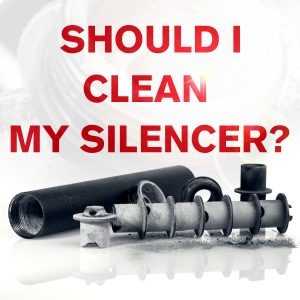 |
- | Cleaning and maintaining a silencer is a task that most suppressor enthusiasts dread. It can definitely be a messy and tedious undertaking. However, depending on the can’s design and classification, there’s no need to fret. Many (read: most) rifle silencers aren’t “user-serviceable.” This means that the units don’t come apart for cleaning because they don’t need it (more on this later). However, pistol and rimfire suppressors are a different ballgame altogether. |
Overview
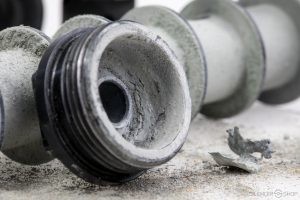
Some silencers require routine cleaning and service, while others don’t. The chief reason to clean a can is to maintain its performance. As more and more carbon fouling builds up in a suppressor, the residue first accumulates in the nooks and crannies of the interior and eventually collects around the opening of each baffle (which can easily alter the bullet as it passes through the openings, causing inconsistent shots fired or possibly even a baffle strike).
If you don’t maintain your lower pressure/caliber suppressors, at some point you’ll essentially have a solid tube of carbon and lead attached to the end of your host firearm. The only way to prevent this problem is to regularly service the unit because the more you shoot, the dirtier your cans will get.
Let’s take a look at the different types of silencers and what kind of maintenance they generally require.
Rimfire Suppressors
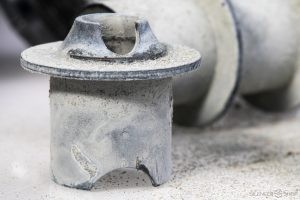
Cleaning a rimfire silencer is challenging because of two factors: what the fouling consists of and how it accrues. Comprised of a mixture of carbon, a minimal amount of unburnt powder, and lead, fouling becomes problematic once the lead is evenly mixed with the carbon in vapor form.
This, in turn, acts like a bonding agent and, once cooled, inevitably sticks to every surface it contacts, specifically the innards of your .22 silencer.
A good/general number of rounds fired between rimfire can maintenance is 300. Disassembly is usually simple, as long as you begin the process before buildup becomes a true nuisance to the suppressor and its components.
Each silencer is a tad different in this respect. Many modern rimfire units prevent the buildup from touching the outer tube by their design. Shielded sleeves (e.g., TacSol Ascent) or “click-together” baffles that incorporate the shield into the baffle itself prevent gunk [that’s a technical term] from gathering between the baffle and tube, which would not allow the baffles to effortlessly slide out of the body.
We’ve seen some click-together baffles slide right out of the tube after thousands of rounds fired. The Q El Camino is a prime example. However, we certainly don’t recommend this kind of stress on your silencer… Cleaning 300 rounds worth of crud [another technical term] is much easier than 1,000 rounds.
Hence, routine service is imperative throughout the life of your rimfire suppressors. Although sometimes difficult to maintain, cleaning a rimfire can is well worth the effort.
Pistol Cans
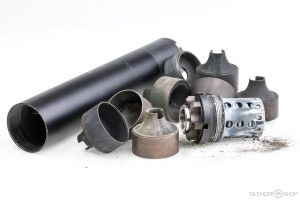
Pistol silencers are also typically user-serviceable. Most pistol ammo is jacketed—or partially jacketed—and lead fouling isn’t an issue, as it is with unjacketed .22LR.
The need to clean a pistol suppressor is mainly just to keep an excess of carbon from building up to the point where you’re losing space inside the silencer for the gasses to be cooled before entering the atmosphere and making noise. The more buildup, the less volume of space there is for the silencer to effectively control the escaping gas.
Thus, keeping the silencer clean means more effective sound suppression and better overall performance.
Rifle Silencers
As a general rule, higher caliber silencers don’t need to be cleaned/maintained. Considering most are sealed units, the ability to break them down and service this category simply doesn’t exist.
There are a few exceptions to this rule. Most notably, the Griffin Optimus and Alpha suppressors.
To that point, because the high velocity ammo used blows most buildup away, rifle cans basically clean themselves. It’s a phenomenon known as “carbon in, carbon out.” A typical centerfire rifle cartridge has enough pressure moving behind the projectile that the silencer will create carbon buildup, but it’ll also have enough “oomph” to push the old carbon out. (In other words, science.)
This leads us to our final point: Carbon buildup in a suppressor might actually make it quieter… Stay with us here.
A very light layer of carbon coating the internal baffles of a silencer is a good thing. This carbon can help dissipate the heat (not to get all “sciency,” but it has to do with the characteristics of carbon, as well as an increase to the internal surface area of the interior).
Don’t confuse this with a heavy carbon accumulation that becomes so built up that it begins to negate the benefit by decreasing the interior volume of the silencer.
Rifle silencers seem to strike the perfect balance of carbon buildup all on their own. This convenience brings more value and practicality to 5.56mm, 7.62mm, and large bore category cans.
Summation
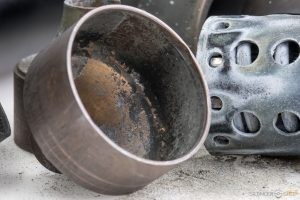
Therefore, the need to clean your silencer depends on the caliber you intend to utilize. Remember, the pesky .22LR ammo is a must-clean scenario (e.g., rimfire cans). Heavier caliber ammo, on the other hand, essentially cleanses itself (e.g., rifle suppressors).
Regardless of upkeep method, a quick word to the wise: DO NOT USE A STEEL BRISSLE BRUSH TO CLEAN ALUMINUM SILENCERS/ACCESSORIES! This’ll result in a damaged, unattractive can. We’ll discuss the ways to clean your suppressors in our next blog post, so make sure you stay tuned!
For more insight regarding suppressor maintenance, feel free to contact us with any questions. Keep ‘em clean, and safe shooting!





